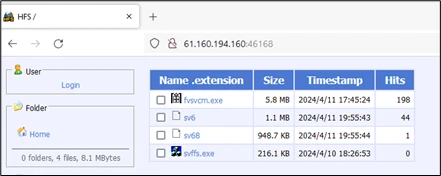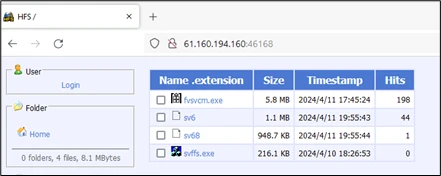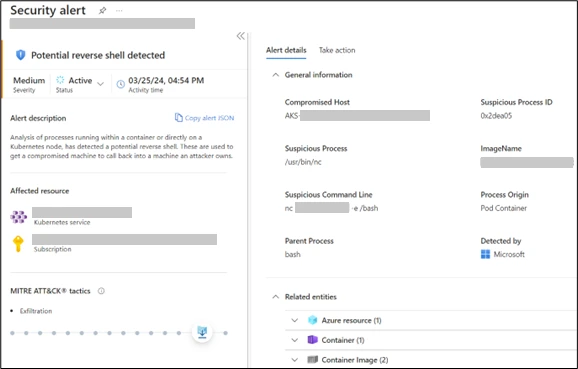
2024-4-18 00:0:0 Author: www.microsoft.com(查看原文) 阅读量:5 收藏
Attackers are constantly seeking new vulnerabilities to compromise Kubernetes environments. Microsoft recently uncovered an attack that exploits new critical vulnerabilities in OpenMetadata to gain access to Kubernetes workloads and leverage them for cryptomining activity.
OpenMetadata is an open-source platform designed to manage metadata across various data sources. It serves as a central repository for metadata lineage, allowing users to discover, understand, and govern their data. On March 15, 2024, several vulnerabilities in OpenMetadata platform were published. These vulnerabilities (CVE-2024-28255, CVE-2024-28847, CVE-2024-28253, CVE-2024-28848, CVE-2024-28254), affecting versions prior to 1.3.1, could be exploited by attackers to bypass authentication and achieve remote code execution. Since the beginning of April, we have observed exploitation of this vulnerability in Kubernetes environments.
Microsoft highly recommends customers to check clusters that run OpenMetadata workload and make sure that the image is up to date (version 1.3.1 or later). In this blog, we share our analysis of the attack, provide guidance for identifying vulnerable clusters and using Microsoft security solutions like Microsoft Defender for Cloud to detect malicious activity, and share indicators of compromise that defenders can use for hunting and investigation.
Attack flow
For initial access, the attackers likely identify and target Kubernetes workloads of OpenMetadata exposed to the internet. Once they identify a vulnerable version of the application, the attackers exploit the mentioned vulnerabilities to gain code execution on the container running the vulnerable OpenMetadata image.
After establishing a foothold, the attackers attempt to validate their successful intrusion and assess their level of control over the compromised system. This reconnaissance step often involves contacting a publicly available service. In this specific attack, the attackers send ping requests to domains that end with oast[.]me and oast[.]pro, which are associated with Interactsh, an open-source tool for detecting out-of-band interactions.
OAST domains are publicly resolvable yet unique, allowing attackers to determine network connectivity from the compromised system to attacker infrastructure without generating suspicious outbound traffic that might trigger security alerts. This technique is particularly useful for attackers to confirm successful exploitation and validate their connectivity with the victim, before establishing a command-and-control (C2) channel and deploying malicious payloads.
After gaining initial access, the attackers run a series of reconnaissance commands to gather information about the victim environment. The attackers query information on the network and hardware configuration, OS version, active users, etc.
As part of the reconnaissance phase, the attackers read the environment variables of the workload. In the case of OpenMetadata, those variables might contain connection strings and credentials for various services used for OpenMetadata operation, which could lead to lateral movement to additional resources.
Once the attackers confirm their access and validate connectivity, they proceed to download the payload, a cryptomining-related malware, from a remote server. We observed the attackers using a remote server located in China. The attacker’s server hosts additional cryptomining-related malware that are stored, for both Linux and Windows OS.

The downloaded file’s permissions are then elevated to grant execution privileges. The attacker also added a personal note to the victims:

Next, the attackers run the downloaded cryptomining-related malware, and then remove the initial payloads from the workload. Lastly, for hands-on-keyboard activity, the attackers initiate a reverse shell connection to their remote server using Netcat tool, allowing them to remotely access the container and gain better control over the system. Additionally, for persistence, the attackers use cronjobs for task scheduling, enabling the execution of the malicious code at predetermined intervals.
How to check if your cluster is vulnerable
Administrators who run OpenMetadata workload in their cluster need to make sure that the image is up to date. If OpenMetadata should be exposed to the internet, make sure you use strong authentication and avoid using the default credentials.
To get a list of all the images running in the cluster:
kubectl get pods --all-namespaces -o=jsonpath='{range .items[*]}{.spec.containers[*].image}{"\n"}{end}' | grep 'openmetadata'
If there is a pod with a vulnerable image, make sure to update the image version for the latest version.
How Microsoft Defender for Cloud capabilities can help
This attack serves as a valuable reminder of why it’s crucial to stay compliant and run fully patched workloads in containerized environments. It also highlights the importance of a comprehensive security solution, as it can help detect malicious activity in the cluster when a new vulnerability is used in the attack. In this specific case, the attackers’ actions triggered Microsoft Defender for Containers alerts, identifying the malicious activity in the container. In the example below, Microsoft Defender for Containers alerted on an attempt to initiate a reverse shell from a container in a Kubernetes cluster, as happened in this attack:

To prevent such attacks, Microsoft Defender for Containers provides agentless vulnerability assessment for Azure, AWS, and GCP, allowing you to identify vulnerable images in the environment, before the attack occurs. Microsoft Defender Cloud Security Posture Management (CSPM) can help to prioritize the security issues according to their risk. For example, Microsoft Defender CSPM highlights vulnerable workloads exposed to the internet, allowing organizations to quickly remediate crucial threats.
Organizations can also monitor Kubernetes clusters using Microsoft Sentinel via Azure Kubernetes Service (AKS) solution for Sentinel, which enables detailed audit trail for user and system actions to identify malicious activity.
Indicators of compromise (IoCs)
| Type | IoC |
| Executable SHA-256 | 7c6f0bae1e588821bd5d66cd98f52b7005e054279748c2c851647097fa2ae2df |
| Executable SHA-256 | 19a63bd5d18f955c0de550f072534aa7a6a6cc6b78a24fea4cc6ce23011ea01d |
| Executable SHA-256 | 31cd1651752eae014c7ceaaf107f0bf8323b682ff5b24c683a683fdac7525bad |
| IP | 8[.]222[.]144[.]60 |
| IP | 61[.]160[.]194[.]160 |
| IP | 8[.]130[.]115[.]208 |
Hagai Ran Kestenberg, Security Researcher
Yossi Weizman, Senior Security Research Manager
Learn more
For the latest security research from the Microsoft Threat Intelligence community, check out the Microsoft Threat Intelligence Blog: https://aka.ms/threatintelblog.
To get notified about new publications and to join discussions on social media, follow us on LinkedIn at https://www.linkedin.com/showcase/microsoft-threat-intelligence, and on X (formerly Twitter) at https://twitter.com/MsftSecIntel.
To hear stories and insights from the Microsoft Threat Intelligence community about the ever-evolving threat landscape, listen to the Microsoft Threat Intelligence podcast: https://thecyberwire.com/podcasts/microsoft-threat-intelligence.
如有侵权请联系:admin#unsafe.sh